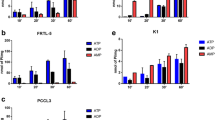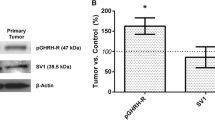Abstract
Papillary and follicular thyroid neoplasms have been documented to have thyrotropin (TSH) receptors and an intact receptor-adenylate cyclase (AC) system. The AC response to TSH in most benign and malignant thyroid neoplasms is greater in the neoplasms than in the adjacent normal thyroid tissue. This increased AC response could be due to abnormal amounts of guanyl nucleotide regulatory (G) proteins, to an altered ratio of stimulating to inhibiting G proteins, or to the coupling of the G proteins—to either the receptor or to the catalytic unit of AC. To study why tumors have a greater AC response to TSH, we first extracted the G proteins from normal and neoplastic human thyroid tissue and placed them in membranes from cyclase minus S49 mouse lymphoma cells that lack a stimulating guanyl nucleotide regulatory protein (Gs). These studies demonstrated that there were comparable amounts of guanyl nucleotide regulatory protein in normal and neoplastic thyroid tissue. We next investigated whether there was an alteration in the ratio of inhibiting (Gi) to stimulating (Gs) guanyl nucleotide regulating proteins in thyroid neoplasms. Pertussis toxin (PT) (10 μg/ml) was used to study the activity of the inhibiting G protein since it stimulates AC activity by inhibiting the inhibitory regulatory protein by adenosine diphosphate ribosylating the alpha subunit of the Gi protein. Cholera toxin (CT) (10 ng/ml) was used because it selectively activates the stimulating G proteins. AC activity was determined by the conversion of [α-32P]ATP to cAMP in pmol/mg protein per 30 minutes. In 11 patients, PT-stimulated AC levels [8.55±1.7 SEM, (mean±standard deviation)] in normal tissues were higher than basal levels of AC (5.14±0.9,p< 0.01). However, there were no differences in basal and PT-stimulated levels in neoplastic tissues (6.43±1.0 and 6.87 ±1.8, respectively). This suggests that there is less Gi protein in the neoplasms since the AC response to PT was greater in normal tissues by 170%, but there was no significant stimulation in neoplastic tissues. In contrast, the AC response to CT (10 μg/ml that directly activates the stimulatory guanyl nucleotide regulatory proteins was greater in neoplastic thyroid tissue (174.3±30.1) than in normal thyroid tissue (78.5±16.3) from the same patients (p<0.01).
These experiments demonstrate that most thyroid neoplasms have less Gi and more Gs protein, which probably accounts for the greater AC response to TSH in thyroid neoplasms. The greater stimulation of Gs and the greater AC response in the neoplasms may be one reason for the more rapid growth of benign and malignant thyroid tumors.
Résumé
Les tumeurs papillaire et folliculaire de la thyroïde ont des récepteurs à la thyrotropine (TSH) et à l'adénylate cyclase (AC). Pour la plupart d'entre elles, la réponse AC à la TSH est plus importante dans les tumeurs bénignes et malignes de la thyroïde que dans le tissu avoisinant normal. Cette augmentation d'activité peut être due: à des quantités anormalement importantes de protéines régulatrices de la guanyl-nucléotide (G), à un rapport anormal de protéines G de stimulation/ protéines d'inhibition, ou à un couplage de protéines G soit au récepteur soit à l'unité de catalyse de l'AC. Pour étudier les raisons pour lesquelles ces tumeurs ont une réponse AC augmentée vis-à-vis de la TSH, nous avons extrait les protéines G des tissus thyroïdes normal et tunoral de l'homme et nous les avons placés sur des membranes d'adénylate-cyclase des cellules lymphomateuses de souris S49 n'ayant pas de protéines de stimulation de la guanyl-nucléotide (Gs). Ces études ont montré qu'il y avait des quantités comparables de protéines régulatrices de la guanyl-nucléotide dans les tissus thyroïdiens normal et tumoral. Nous avons ensuite mesuré le rapport des protéines régulatrices de la guanyl-nucléotide d'inhibtion (Gi) et de stimulation (Gs) dans les tumeurs thyroïdiennes. La toxine pertussis (TP) (10 μg/ml) a été utilisée pour étudier l'activité de la protéine G d'inhibition puisqu'elle stimule l'activité AC en inhibant la protéine d'inhibition par ribosylation ADP de la sous-unitéα de la protéine Gi. La toxine choléra (TC) (10 ng/ml) active sélectivement les protéines G de stimulation. L'activité AC a été déterminée par la conversion de l'[α-32P]ATP en cAMP dosée en pmol/mg de protéine/30 minutes. Chez 11 patients, les taux d'AC stimulés par la TP étaient plus élevés (8.55±1.7, moyenne±écart type) que les taux d'AC de base dans les tissus normaux (p<0.01). Cependant, aucune différence significative n'a été trouvée entre les taux d'AC de base et après stimulation par la TP dans les tissus néoplasiques (6.43±1.0 vs. 6.87±1.8, respectivement). Cela suggère qu'il y a moins de protéine Gi dans le tissu néoplasique puisque la réponse AC à la TP était supérieure par rapport aux tissus normaux de 170%, mais sans stimulation significative dans les tissus néoplasiques. En revanche, la réponse AC à la TC était supérieure dans les tissus néoplasiques (174.3±30.1) par rapport aux tissus normaux (78.5±16.3,p<0.01) chez ces mêmes patients.
Ces expériences démontrent que, par rapport au tissu thyroïdien normal, la plupart des néoplasmes thyroïdiens contiennent moins de Gi et plus de Gs, ce qui explique probablement la réponse AC à la TSH plus importante dans les néoplasmes. La plus grande stimulation des Gs et la réponse AC plus importante dans les tissus néoplasiques pourraient expliquer la croissance plus rapide des tumeurs thyroïdiennes bénigne ou maligne.
Resumen
Se ha podido documentar la presencia de receptores de tirotropina (TSH) y de un sistema receptor de TSH-adenilato ciclasa (AC) en los neoplasmas papilares y foliculares de la glándula tiroides. La respuesta de la AC a la TSH en la mayoría de los neoplasmas benignos y malignos de la tiroides es mayor en el tejido neoplásico que en el tejido tiroideo normal adyacente. Esta respuesta aumentada de la AC puede ser debida a cantidades anormales de las proteínas regulatorias guanil nucleótidas (G), a una alteración en la relación entre las proteínas G estimulantes e inhibitorias o a una ligazón de las proteínas G bien al receptor o a la unidad catalítica de la AC. Con el fin de estudiar por qué los tumores poseen una mayor capacidad de respuesta de la AC a la TSH, primera hicimos la extracción de las proteínas G de tejidos tiroideos humanos normales y neoplásicos y los colocamos en membranas de ciclasa menos células del linfoma S49 del ratón que carecen de G. Estos estudios demonstraron que existían cantidades comparables de G en los tejidos tiroideos normal y neoplásico. A continuación investigamos si existía una altercación en la relación entre las proteínas regulatorias guanil nucleótidas inhibidoras (Gi) y estimulantes (Ge) en los neoplasmas tiroideos. Se utilizó toxina de pertusis (PT) (10 μg/ml) para determinar la actividad de la Gi, puesto que ésta estimula la actividad de AC mediante la inhibición de la proteína regulatoria inhibidora por la ribosilación por ADP de la subunidad alpha de la proteína Gi. Se utilizó toxina del cólera (CT) (10 ng/ml) por cuanto ésta activa en forma selectiva las proteínas G estimulantes. La actividad de AC fue determinada por la tasa de conversion de [α-32P]ATP a cAMP en pmpl/mg de proteína por 30 minutos. En 11 patientes los niveles de AC estimulada por PT (8.55±1.7) en los tejidos normales fueron superiores a los niveles basales de AC (5.14±0.9,p<0.01). Sin embargo, no se observó diferencia entre los niveles basales y los niveles estimulados por PT en los tejidos neoplásicos (6.43±1.0 y 6.87±1.8, respectivamente). Esto sugiere que existe menos proteína Gi en los neoplasmas puesto que la respuesta de AC a la PT fue mayor en un 170% en los tejidos normales y no se presentó estimulación significativa en los tejidos neoplásicos. En contraste, la respuesta de AC a la CT (10 μg/ml) que directamente activa las proteínas regulatorias guanil nucleotidas, fue mayor en el tejido neoplásico tiroideo (174.3±30.1) que en el tejido tiroideo normal (78.5±16.3) extraídos del mismo paciente (p<0.01).
Estos experimentos demuestran que la mayoría de los neoplasmas tiroideos poseen menos proteína Gi y más proteína Ge, lo cual probablemente explica el mayor grado de respuesta de la AC a la TSH en los neoplasmas tiroideos. El mayor estímulo de Ge y el mayor grado de respuesta de la AC en los neoplasmas puede representar la razón del crecimiento más rápido de los tumores benignos y malignos de la tiroides.
Similar content being viewed by others
References
Duh, Q.Y., Clark, O.H.: Factors that influence the growth of normal and neoplastic thyroid tissue. Surg. Clin. North Am.67:281, 1987
Dumont, J.E.: The action of thyrotropin on thyroid metabolism. Vitam. Horm.29:287, 1971
Tanabe, A., Nielsen, T.B., Rani, C.S.S., Field, J.B.: Thyroid cell responses to thyrotropin and 12-D-tetradecanoyl-phorbol-13-acetate: Translocation of protein kinase C and phosphorglation of thyroid cell polypeptide substrates. Arch. Biochem. Biophys.243: 92, 1985
Friedman, Y., Poleck, T., Henricks, L., Burke, G.: Diacylglycerol-activated, calcium/phospholipid-dependent protein kinase (protein kinase C) activated in bovine thyroid. Biochem. Biophys. Res. Comm.130:971, 1985
Field, J.B., Bloom, G., Chow, M.C.Y., Kerns, P., Larsen, P.R., Kotani, M., Kariya, T., Jekker, A.: Effects of thyroid-stimulating hormone on human thyroid carcinoma and adjacent normal thyroid tissue. J. Clin. Endocrinol. Metab.47:1052, 1978
Clark, O.H., Castner, B.J.: Thyrotropin “receptors” in normal and neoplastic thyroid tissue. Surgery85:624, 1979
Clark, O.H., Gerend, P.L., Cote, T.C., Nissenson, R.A.: Thyrotropin binding and adenylate cyclase stimulation in thyroid neoplasms. Surgery90:252, 1981
Saltiel, A.R., Powell-Jones, C.H.J., Thomas, Jr., C.G., Nayfeh, S.N.: Thyrotropin receptor-adenylate cyclase function in human thyroid neoplasms. Cancer Res.41:2360, 1981
Clark, O.H., Gerend, P.L., Goretski, P., Nissenson, R.A.: Characterization of the TSH receptor-adenylate cyclase system in neoplastic human thyroid tissue. J. Clin. Endocrinol. Metab.57: 140, 1983
Clark, O.H., Gerend, P.L.: Thyrotropin regulation of adenylate cyclase activity in human thyroid neoplasms. Surgery97:539, 1985
Clark, O.H., Gerend, P.L., Nissenson, R.A.: Mechanisms for increased adenylate cyclase responsiveness to TSH in neoplastic human thyroid tissue. World J. Surg.8:466, 1984
Teitelbaum, A.P., Nissenson, R.A., Zitzner, L.A., Simon, K.: Dual regulation of PTH-stimulated adenylate cyclase activity by GTP. Am. J. Phys.251:F858, 1986
Lowry, O.H., Rosebrough, N.J., Farr, A.L., Randall, R.J.: Protein measurement with the folin phenol reagent. J. Biol. Chem.193:265, 1951
Salomon, Y., Londos, C., Rodbell, M.: A highly sensitive adenylate cyclase assay. Ann. Biochem.58:541, 1974
Ross, E.M., Maguire, M.E., Sturgill, T.W., BiHonen, R.L., Oilman, A.G.: Relationship between the B-adrenergic receptor and adenylate cyclase. J. Biol. Chem.252:5761, 1977
Stiles, G.L., Lefkowitz, R.J.: A reconstitution assay for the guanine nucleotide regulatory protein of adenylate cyclase system using turkey erythrocyte membranes as the acceptor preparation. Arch. Biochem. Biophys.217:368, 1982
Murayama, T., Ui, M.: [3H] release from rat and hamster adipocyte membranes independently linked to receptors involved in activation or inhibition of adenylate cyclase. J. Biol. Chem.259:761, 1984
Moss, J., Stanley, S.J., Burns, D.L., Hsia, J.A., Yost, D.A., Myers, G.A., Hewlett, E.L.: Activation by thiol of the latent NAD glycohydrolase and ADP-ribosyltransferase activities of Bordetella pertussis toxin (islet activating protein). J. Biol. Chem.258:11879, 1982
Bourne, H.R.: Yeast RAS and Tweedledee's logic. Nature317:16, 1985
Downs, Jr., R.W., Aurbach, G.D.: The effects of forskolin on adenylate cyclase in S49 wild type and cyc minus cells. J. Clin. Nucl. Res.8:235, 1982
Toda, T., Uno, I., Ishikawa, T., Powers, S., Katapka, T., Broek, D., Cameron, S., Broach, J., Matsumoto, K., Wigler, M.: In yeast, RAS proteins are controlling elements of adenylate cyclase. Cell40:27, 1985
Nishizuka, Y.: Studies and perspectives of protein kinase C. Science233:305, 1986
Tanabe, A., Nielsen, T.B., Yoshimura, Y., Field, J.B.: Phospholipid-sensitive Ca2+-dependent protein kinase from bovine thyroid: Characteristics and subcellular distribution of the enzyme and its substrates. Metabolism35:457, 1986
Author information
Authors and Affiliations
Additional information
Supported in part by the Medical Research Service of the Veterans Administration Medical Center, San Francisco, California, U.S.A.
Rights and permissions
About this article
Cite this article
Clark, O.H., Gum, E.T., Siperstein, A.E. et al. Guanyl nucleotide regulatory proteins in neoplastic and normal human thyroid tissue. World J. Surg. 12, 538–544 (1988). https://doi.org/10.1007/BF01655445
Issue Date:
DOI: https://doi.org/10.1007/BF01655445




